Cappadocia in winter transforms into a surreal winter wonderland when the colder months blanket its unique landscape. As the region’s iconic fairy chimneys and otherworldly rock formations stand stoically against the crisp winter air, a serene and enchanting atmosphere settles over this historical marvel.
The usually bustling hot air balloon-filled skies give way to a quieter, more introspective scene, where the powdery snow blankets the earth, casting a hushed spell over the region’s ancient caves and valleys.
Winter in Cappadocia unveils a different side of its magic, inviting you to explore a quieter, contemplative beauty that contrasts with the vibrant energy of its more populous seasons.
Cappadocia in Winter
When I thought about visiting as I was backpacking in Turkey during January I thought it might not be the best to see things with the snow everywhere and maybe some activities in Cappadocia not running.
If you’re thinking of going to Cappadocia in winter then just do it. It’s like another planet.
Although it is a little trickier with bus transport sometimes due to the snow your efforts will be worth it. As you enter the area you will see the famous snow-covered fairy chimneys that Cappadocia is known for.
Get a good place to stay in Goreme, which is the main settlement in the area (rock cave hotels are the best) and chill out (no pun intended) before going out into nature.
There are loads of areas around Goreme to see.
It’s best to start with the Goreme Open-Air Museum as it’s only around 15 15-minute walk from Goreme town and gives a starter insight into the place.
I should reiterate at this point the main benefit of going to Goreme and Cappadocia in winter and that is the lack of people!
Seriously when I look at summer pics from the area it’s all tour groups etc around but when there in January half the time I had some places all to myself, or at worse just a few other travellers.
Along with the snow, it is a much more peaceful atmosphere.
And actually, that’s the main reason I’m writing this post. It’s not about “go see this, go see that” as there are plenty of articles that tell you all the things to do in Cappadocia.
I’m writing this purely to show you what it’s like in winter and why you should go at that time of year. The pictures can do all the talking.
Having said that the main eight areas that you should go to are:
Fairy Chimneys in Cappadocia in Winter
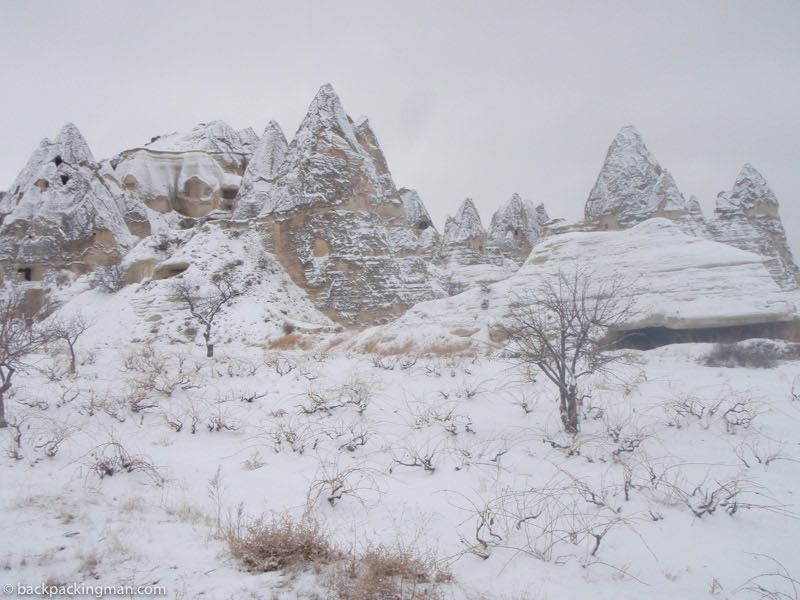
These are the famous geological formations that you should see.
Goreme Open Air Museum
The Goreme Open Air Museum, a UNESCO World Heritage Site, unveils a mesmerizing tableau of ancient rock-cut churches, monasteries, and chapels that echo the rich cultural and religious history of the area.
Carved into the soft tuff rock by monks during the Byzantine era, these architectural marvels date back to the 4th century and stand as a testament to the profound impact of Christianity in the region.
As you step into this open-air sanctuary, you are greeted by a surreal landscape of fairy chimneys and intricately carved facades, each telling a story of devotion, resilience, and artistic ingenuity.
The interiors of these cave churches are adorned with vibrant frescoes, depicting scenes from the Bible with a timeless vibrancy that defies the centuries that have passed since their creation. In winter in Cappadocia, serene tranquillity blankets the site, adding an extra layer of enchantment to the already captivating surroundings.
Rose Valley
Rose Valley unfolds as a natural masterpiece and is one of the best hiking trains in the region. Named after the rose-coloured hues that grace its rock formations during the soft glow of sunrise and sunset, this valley is a testament to the geological wonders that define the region.
The undulating landscape, sculpted by centuries of wind and water erosion, presents a surreal panorama of fairy chimneys, cave dwellings, and unique rock formations that captivate the imagination.
Beyond its geological marvels, Rose Valley is dotted with ancient cave churches adorned with well-preserved frescoes that narrate tales of faith and artistic brilliance. These hidden gems within the valley offer a glimpse into the spiritual history of Cappadocia, where the rock itself becomes a canvas for expressions of devotion.
Red Valley
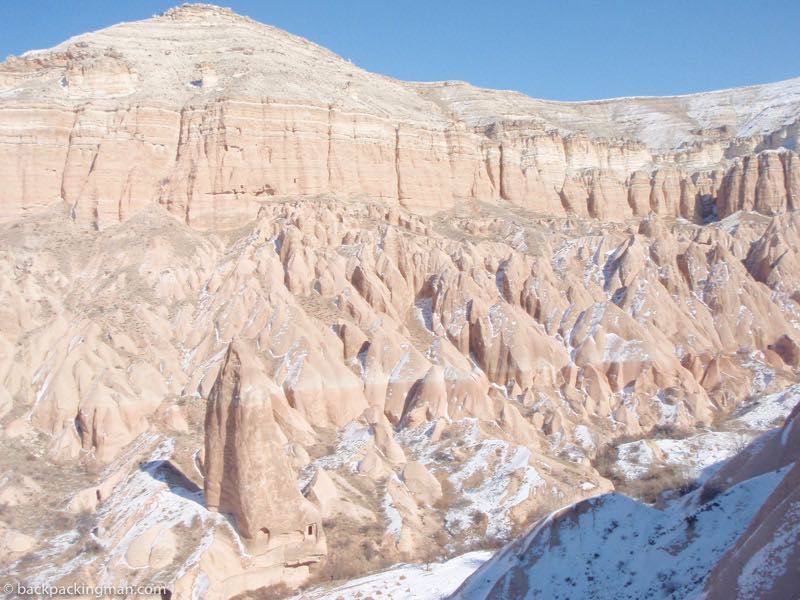
Another good hiking trail to go hiking on which is also a great sunset spot as well.
Uchisar Castle
Uchisar Castle is one of the highest points in Cappadocia and offers breathtaking panoramic views of the surrounding valleys and mountains.
Pasabag Valley
This is a very popular place, although in winter in Cappadocia I didn’t see many people there. It’s where you can see some of the Fairy Chimneys mentioned before and cave dwellings.
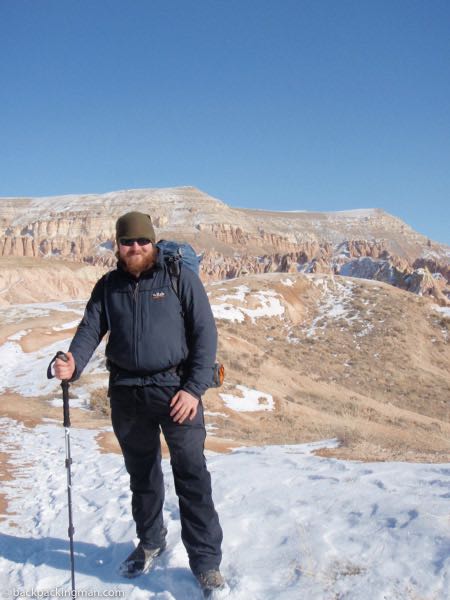
Pigeon Valley Trail
The Pigeon Valley Trail is a relatively easy hiking route. The trail meanders through the valley, providing opportunities to discover the unique rock formations and cave dwellings along the way.
One of the distinctive aspects of Pigeon Valley is the presence of numerous pigeon houses carved into the cliffs. These small cavities served as homes for pigeons, and their droppings were used as fertilizer for the fields.
The relationship between the local people and pigeons in Cappadocia has historical and agricultural significance.
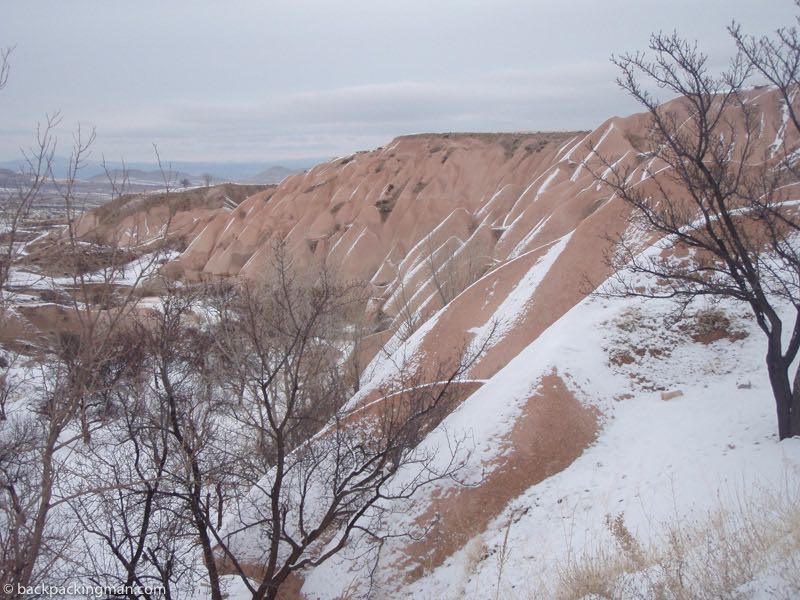
Underground Cities
Cappadocia is famous for its underground cities, which are remarkable historical and cultural sites. These underground cities were carved into the soft volcanic rock of the region and served various purposes, including shelter from invaders, storage of food and water, and places of worship.
These are some of the well-known underground cities in Cappadocia.
Derinkuyu is one of the largest and deepest underground cities in Cappadocia, extending several levels below the ground. It is estimated to have been built in the 7th or 8th century BC and could accommodate thousands of people. Derinkuyu features a complex network of tunnels, rooms, and storage areas.
Kaymaklı is another impressive underground city in Cappadocia, known for its multi-level structure. While not as extensive as Derinkuyu, Kaymaklı is still a significant archaeological site with various chambers, including stables, cellars, and chapels. It is thought to have been inhabited during the Hittite period.
Özkonak is a smaller underground city compared to Derinkuyu and Kaymaklı, but it’s equally fascinating. It has fewer levels and chambers, but it offers a glimpse into the architectural and engineering marvels of the underground cities in Cappadocia.
Ürgüp is known for its unique underground dwellings and tunnels. It is believed that these underground structures were initially created as storage spaces and later expanded for use as shelters during times of danger.
You can see the holes in the cliffs that were home to the cave dwellers in the past.
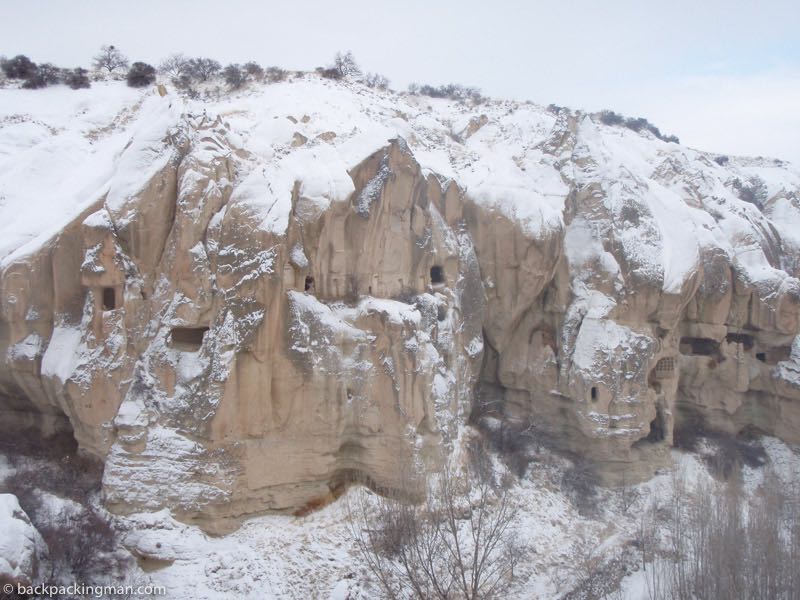
Goreme is practically hard to see when covered in snow as it blends into its surroundings so well.
Goreme in winter.
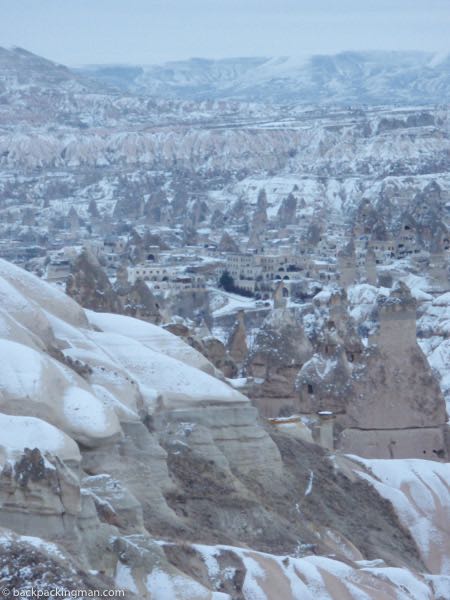
Hammam Bath
The final recommendation from my own experience of what to do in Cappadocia in winter is, to have a hammam bath. This is the traditional Turkish bath and after a cold day out is the perfect way to unwind and warm up.
Some of the cave hotels offer a hammam bath to their guests and some also offer the spa service to non-guests. Book ahead to make sure you get a spot. One of the best ones for a hammam bath in Cappadocia is the Panoramic Cave Spa.
A highly recommended place to stay in Goreme, although not a budget-friendly option, is the Village Cave House Hotel where your room is inside a cave-like in the old days.
At the end of the day enjoy a warm meal, sit on comfy carpets with cushions, and get heated up from the cold.
The cave hotels are your best option to get a real local experience and they are surprisingly warm in Cappadocia in winter.
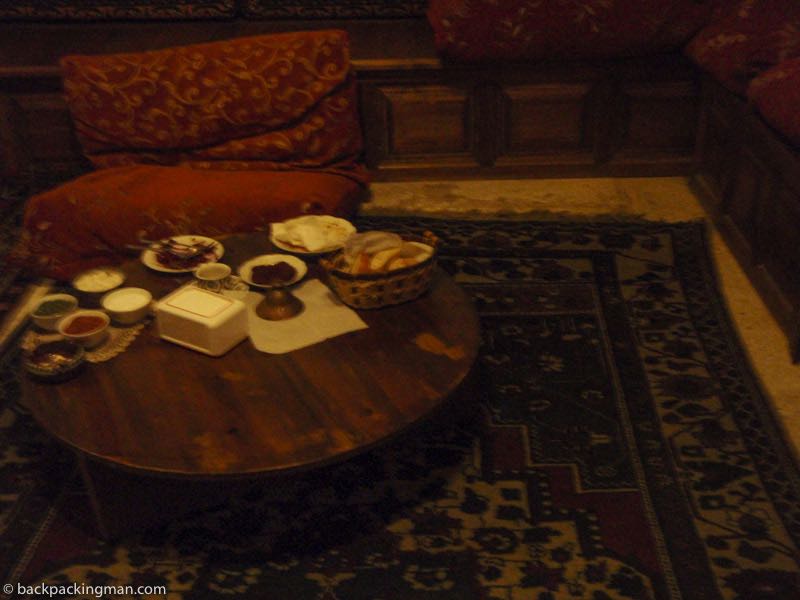
Hot Air Balloon Trip in Cappadocia
A hot air balloon tour in Cappadocia is highly recommended although I didn’t do an air balloon trip when there (the weather and budget constrained me) and didn’t see any when out and about.
And that’s one of the problems and downsides to visiting Cappadocia in winter is that some activities might not be running due to the weather conditions.
Stock photo of air balloons in Cappadocia.
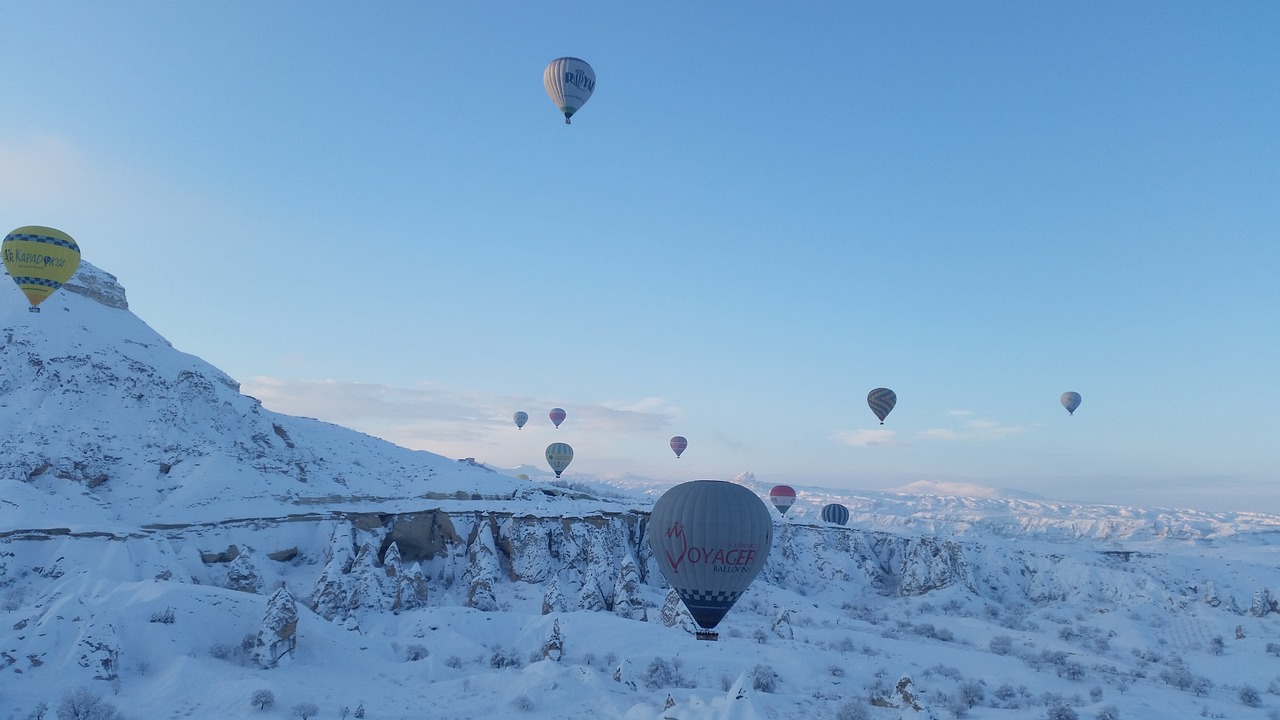
Technically air balloon rides do go on in winter but are weather dependent and in winter the conditions are worse than in summer (obviously) with more winds etc.
However, if you want to do a ride and they are running when there this is a tour that is recommended by other travellers:
Cappadocia in Winter Travel Advice
If you want to know how to get to Cappadocia from Istanbul then one option is to take the bus which will take around 12 hours. I had a bit of a problem for a few hours on the bus due to deep snow but we made it.
The best option time-wise is to fly from Istanbul to Cappadocia which takes just over an hour to reach and if you’re lucky you can find cheap bargains on flights (as low as $20).
Fly from Istanbul Atatürk Airport it’s easier to reach. The flights will land at Kayseri Airport where you can take a shuttle to the hotel.
Find places to stay in Cappadocia here.
For more reading on Turkey have a look at my post on how to travel from Ankara to Kars on the sleeper train in winter.
The best guidebook for Turkey I have found is the Lonely Planet Turkey Guide.
Enjoy Cappadocia in winter!
Cappadocia is a magical place you should visit and don’t be put off by visiting Cappadocia in winter.
Embracing the chilly embrace of winter, Cappadocia emerges as a captivating destination where history, nature, and the spirit of the season converge in a truly captivating dance.
If you liked this article about visiting Cappadocia in winter a share would be cool (pun intended)
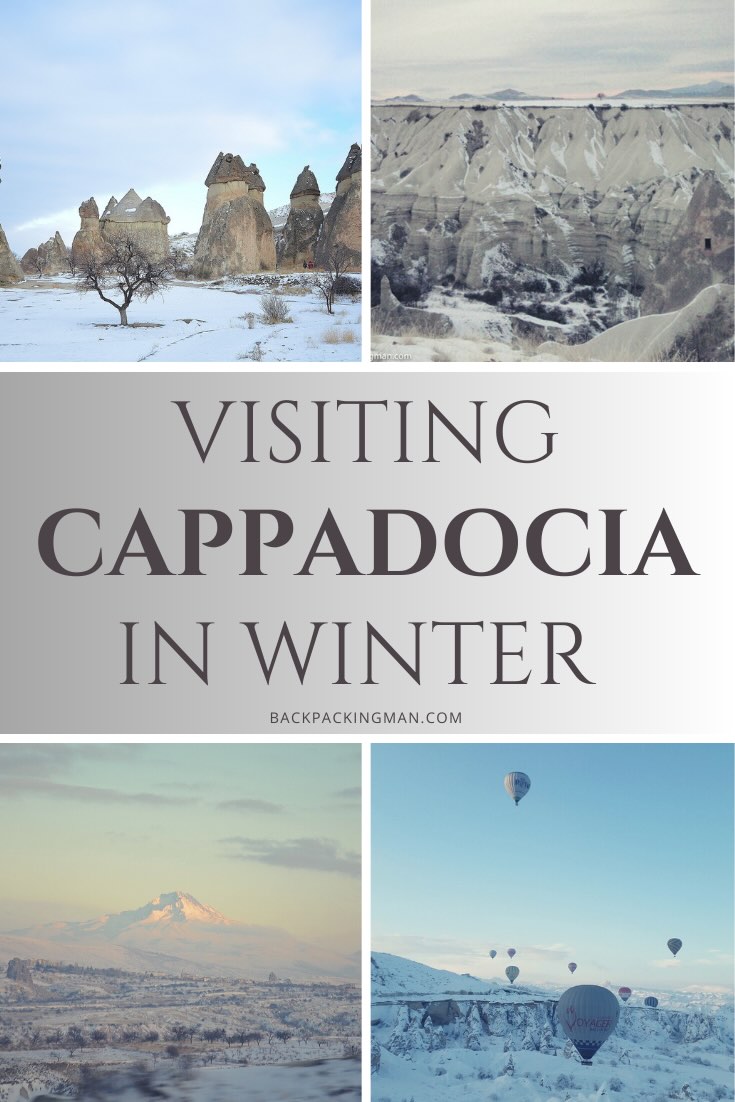




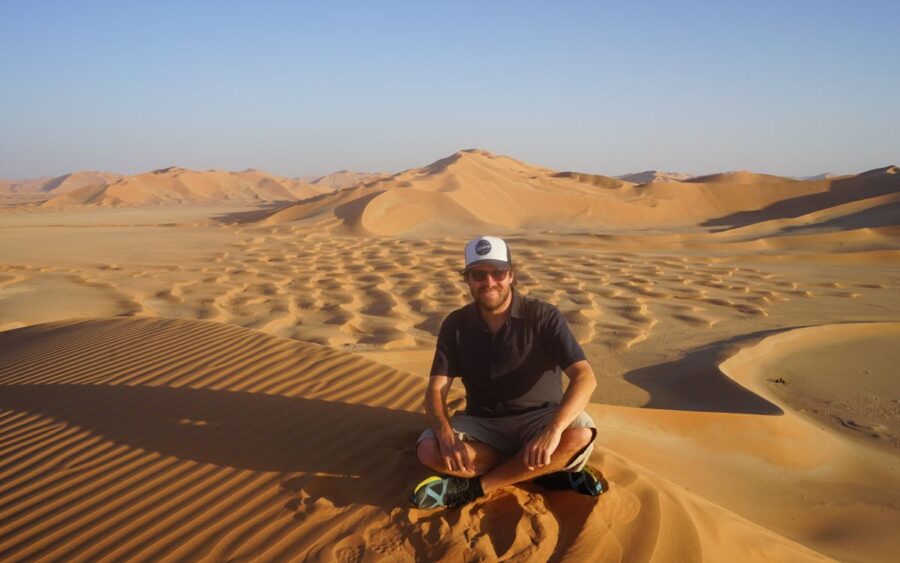
Pingback: What To Do In Istanbul In One Day - Backpackingman